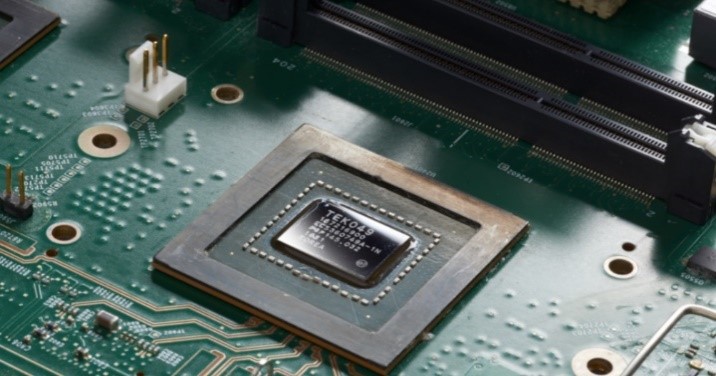

Advancements in serial data communications, power management and power conversion technologies have made capturing, observing, and analyzing more intricate signal details crucial for accurate measurements and efficient troubleshooting. Tektronix’s 4, 5, and 6 Series oscilloscopes are meeting that demand by enabling higher resolution with their 12-bit ADC acquisition systems.
The goal of this blog post is to explore how our custom-built ASICs enable that increased resolution by delivering:
- Higher performance ADC (12-bit)
- High definition waveform displays
- Improved low noise, high gain analog front end
- Hardware filters to eliminate inherent noise
Higher performance ADC (12-bit)

Figure 1: New Tektronix 12-bit ASIC (The TEK049)
The new TEK049 ASIC uses four 12-bit successive approximation ADCs (Figure 1) to deliver 25 GS/s. Depending on channel count, there can be one or two ASICs per 4, 5 or 6 Series MSO.
Since the ADCs built into the TEK049 ASIC are 12-bit, they provide 4,096 vertical digitizing levels, which is 16x more vertical resolution than previous 8-bit ADCs. In the 4 and 5 Series MSO, they deliver finished 12-bit samples at 3.125 GS/s. At 6.25 GS/s the data is acquired through the 12-bit ADC but are stored in 8-bits of storage memory to accommodate the maximum transfer rate between the ASIC and memory. In the 6 Series MSO, they deliver finished 12-bit samples at 12.5 GS/s. At 25 GS/s the data is acquired through the 12-bit ADC but are stored in 8-bits of storage memory to accommodate the maximum transfer rate between the ASIC and memory.
HD Display Processing for Enhanced Waveform Viewing Capabilities
The TEK049 ASIC also incorporates display processing hardware that enables 4/5/6 Series MSOs to support a large HD display with a lively update rate. Having 1920 x 1080 pixels available allows the oscilloscope to take advantage of the higher ADC resolution and facilitate the viewing of important signal details. In other oscilloscopes the display system compresses the ADC codes into the number of vertical pixels available, which keeps a user from seeing important details that the ADC captured. The TEK049 also enables a very fast update rate with 16-bit color depth. This fast update rate with gray scaling allows users to pick out key features of the waveform, further enhancing the viewing capabilities for those who demand fine signal details.
Lower Noise and Greater Gain for High Bandwidth and Low Volts-Per-Division Settings
Tek’s new ASICs also enable our scopes to support a wide range of full scales on the scope’s display. In the 4/5/6 Series MSOs, an amplifier and attenuator system in the front end adjust the gain to always take advantage of the ADCs full scale. The amplifier noise needs to be very low to take advantage of the high-resolution ADC and enable the scope to be used at high bandwidths and at low volts-per-division settings.

Figure 2: New Tektronix analog amplifier ASIC (TEK061)

Figure 3: New Tektronix analog front end ASIC (TEK026D)
The new TEK061 ASIC (Figure 2) in the 6 Series MSO provides industry leading performance at high bandwidth and small vertical scales. The new TEK026D (Figure 3), available on the 4, 5 or 6 Series, ensures very low noise and even enables accurate probing to 1 GHz without the addition of noise from a probe amplifier.
Hardware Filter Techniques for Improving Vertical Resolution
In general, oscilloscope ADCs are always running at maximum sample rate, no matter what the settings are. When lower sample rates are set by the user, sample points are decimated (thrown out) to store the desired record length / sample rate combination. This mode, in which extra samples are thrown out, is called “sample mode”. Tektronix has traditionally offered a more productive use for “extra” samples with an approach called high resolution or “HiRes” mode. Sample points are averaged together to create the desired sample rate in a process often referred to as ‘boxcar averaging’. Each sample point is made up of more information, providing better accuracy, and effectively delivering higher vertical resolution. Figure 4 illustrates sample mode vs HiRes (boxcar averaging) mode. This technique is widely-used today.

Figure 4: Sample mode vs HiRes (boxcar average) mode.
The 4/5/6 Series MSOs improve on the boxcar averaging, or “HiRes” approach. The new high-resolution mode (dubbed High Res) uses hardware in the TEK049 ASIC to not only perform averaging, but also implement anti-aliasing filters and a uniquely-designed set of finite impulse response (FIR) filters for each sampling rate to ensure the user gets the best high-resolution representation of the original signal being measured.

Figure 5: Step response of High Res, boxcar averaged, and brick wall filtered signals.
Conclusion
Capturing, observing, and analyzing the fine details of various signals has never been more crucial for both designing and troubleshooting cutting-edge technology. At Tektronix, we’re committed to empowering engineers’ innovations by improving the tools they use on a daily basis. 12-bit ADCs powered by a new custom ASIC in the 4/5/6 Series MSOs are just one example.
If you’d like to read a more in-depth explanation of the technology behind our new ASIC, check out our white paper: Achieve Higher Vertical Resolution for More Precise Measurements.
You can also learn more on our product pages for the 4 Series MSO, 5 Series MSO, and 6 Series MSO.


